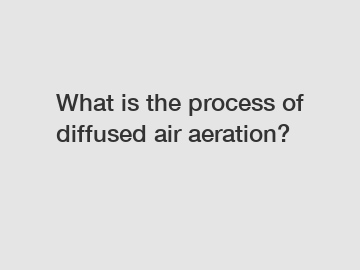What is the process of diffused air aeration?
When it comes to wastewater treatment, diffused air aeration is a key process that plays a crucial role in breaking down organic matter and removing contaminants from water. In this blog post, we will explore the ins and outs of diffused air aeration, from its basic principles to its application in wastewater treatment plants.
The process of diffused air aeration typically begins with the installation of diffuser units in aeration tanks or basins. These diffusers are designed to release fine bubbles of air into the water, allowing for maximum contact between the oxygen and the water. The bubbles rise to the surface, creating turbulence and mixing the water to ensure uniform distribution of oxygen throughout the tank.
One of the key advantages of diffused air aeration is its efficiency in oxygen transfer. The fine bubbles have a large surface area, which allows for rapid diffusion of oxygen into the water. This results in higher oxygen levels in the water, promoting the growth of aerobic bacteria and enhancing the overall treatment process.

In addition to promoting the growth of aerobic bacteria, diffused air aeration also helps to maintain optimal conditions for other biological processes in the water. By maintaining high levels of dissolved oxygen, this process supports the growth of nitrifying bacteria, which are responsible for converting ammonia into nitrate. This is essential for preventing the buildup of harmful nitrogen compounds in the water.
The process of diffused air aeration is not limited to wastewater treatment plants. It is also commonly used in aquaculture, where it plays a vital role in maintaining the health and productivity of aquatic environments. By providing aeration to fish tanks and ponds, diffused air aeration ensures that fish have an adequate supply of oxygen for respiration, while also promoting the breakdown of waste products.
Overall, diffused air aeration is a versatile and effective process that is essential for maintaining the health and quality of water in a variety of applications. Whether in wastewater treatment plants or aquaculture facilities, this process plays a crucial role in promoting the growth of beneficial bacteria and ensuring optimal conditions for biological processes.
In conclusion, diffused air aeration is a critical process in wastewater treatment that promotes the growth of aerobic bacteria and enhances the overall treatment process. By efficiently transferring oxygen into the water, this process creates the ideal conditions for biological processes to thrive, resulting in the effective removal of contaminants from the water. Whether in aeration tanks or fish ponds, diffused air aeration is a versatile and essential tool for maintaining the health and quality of water in a variety of applications.
For more information, please visit frp panel water tank, ceramic rings aquarium, stainless steel water storage.

Comments
0